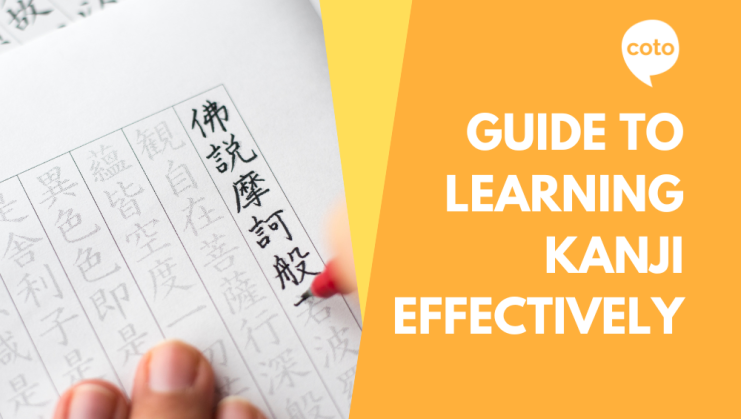
If you’re learning Japanese, you’ve probably heard of kanji — those intricate characters that make up a significant part of the written language. But with over 50,000 kanji characters in existence, it’s easy to feel overwhelmed and wonder if you’ll ever be able to read and write kanji.
The good news is, you don’t need to know all 50,000 characters to be able to read and write proficiently in Japanese. In fact, mastering just a few hundred kanji can take you a long way.
But how do you know which ones to focus on? In this ultimate guide to mastering kanji, we’ll explore the most commonly used characters, how to learn them efficiently, and tips for retaining and applying your newfound knowledge.
Jump to:
- What is kanji?
- Why learning Kanji is important
- How many kanji should you learn in a day?
- How many kanji do you need to know?
- 8 steps to learning Kanji effectively
- Common mistakes to avoid when you learn kanji
What is kanji?
Kanji is one of the three main scripts used in Japanese writing, along with hiragana and katakana. It consists of characters borrowed from the Chinese writing system, with each character representing a specific concept or idea.
Why learning Kanji is important
Kanji is an essential component of the Japanese language. Unlike Hiragana and Katakana, which are phonetic scripts, Kanji is a logographic script that uses symbols to represent words or ideas. Japanese sentences can contain a mix of Kanji, Hiragana, and Katakana, making it necessary to understand all three scripts to read and write in Japanese fluently.
Kanji is used extensively in Japanese literature, newspapers, magazines, and even in everyday communication. Kanji is also used in the names of businesses, streets, and buildings, making it an essential part of Japanese culture. Therefore, learning Kanji is crucial for anyone who wants to become fluent in the Japanese language.
But beyond that, as you improve your Japanese language skills, you’ll notice that it’s easier to read texts with kanji than texts with just hiragana and katakana. Why? Kanji characters provide visual cues and help break up the text into meaningful units.
You have to remember that, unlike English, written Japanese does not have spaces in between particles or words. For example:
わたしはいぬがすきです。
Watashi wa inu ga suki desu.
Imagine reading a text in English like this:
Ilikedogs.
Not so readable, right? Now, if we change some of the hiragana into kanji, it would look like this:
私は犬が好きです。
Unlike hiragana or katakana, which consist of phonetic symbols, kanji characters have distinct shapes and visual pattern. By using kanji, written information can be conveyed more concisely compared to using only hiragana or katakana. This means you have a better chance of quickly grasping the overall meaning of a sentence.
How many kanji should you learn in a day?
The number of kanji characters you can learn in a day will vary depending on various factors, including your learning style, available study time, and personal capabilities.
For now, we’ll use the curriculum in Japanese classes as a reference. Most beginner to intermediate language classes will spend a section of the lesson learning 5 to 10 kanji characters per day.
Now, this is different than more-intensive classes, where you can expect to learn 20 kanji characters per day! Keep in mind that the more advanced you get, the more complicated and less common the kanji will be, making learning even more difficult.
So it’s safe to say that it’s manageable to learn around 5-10 kanji characters per day. Some people may be able to handle more, but most learners make the mistake of cramming as much kanji as they can before a test.
Our tip is: don’t do it. It’ll lead you to burnout and you wouldn’t be able to retain any of the new things you learned. It’s crucial to balance quantity with quality. Spending sufficient time to understand and retain the meaning, readings, and stroke order of each kanji is vital for long-term retention.
How many kanji do you need to know?
First, let’s use the number of kanji characters covered in each JLPT level.
For JLPT N5, which tests you on basic Japanese that you can often learn in a classroom environment, you’ll need to learn 100 kanji characters. If you learn 5-10 kanji per day, you’ll be able to reach your target in around 10-20 days.
For JLPT N4, you’ll have to learn additional 200 kanji characters — 300 kanji in total! Ideally, you can learn this in one to two months!
The JLPT N3 exam covers around 650 kanji. Of course, you do not have to know all of them to pass, but it’s impossible to predict which ones will be on the exam.
You’ll need to learn 1,000 kanji for JLPT N2, while it takes 2,000 kanji for JLPT N1!
By the time you are studying for the N1, you probably have already formed a solid study routine for Japanese kanji and vocabulary. Because the JLPT N1 tests you on a lot of kanji and vocabulary, it is most efficient to memorize the kanji based on its usage rather than its individual meaning and pronunciation.
Now, to be considered fluent in Japanese, you need to know 1,500 to 2,500 kanji — roughly N2 or N1 level.
While there are technically more than 50,000 kanji characters, there is something known as the joyo kanji (常用漢字). Joyo kanji refers to a list of kanji characters that are designated as “regular-use kanji” by the Japanese government. The term “joyo” (常用) translates to “regular use” or “daily use.”
The current Joyo Kanji list was established by the Japanese Ministry of Education in 1981 and has undergone revisions since then. The list originally consisted of 1,945 kanji characters, but it was expanded to 2,136 characters in 2010. These characters are taught in Japanese schools and are considered fundamental for literacy in Japan.
8 steps to learning Kanji effectively
1. Learn basic Japanese words and writing systems first
If you are taking a beginner-level Japanese class, don’t expect the teachers to dive in straight into kanji on the first day! It is generally recommended to learn basic Japanese words and the writing systems of hiragana and katakana before diving into kanji. Understanding hiragana and katakana is fundamental for reading and writing Japanese because they represent the phonetic sounds of the language.
Building a foundation of basic vocabulary is also important because it allows you to understand and communicate in Japanese even without kanji. Learning essential words, phrases, and grammar structures will help you develop a solid understanding of the language’s structure and enable you to form simple sentences.
Once you have a grasp of hiragana, katakana, and basic vocabulary, you can then gradually introduce kanji into your studies.
@cotoacademy 5 Kanji in 20 seconds🤔 #cotoacademy #japanese #studyjapanese #learnjapanese #kanji #5kanjiin20seconds #fyp #fypシ ♬ Countless – Official Sound Studio
2. Set realistic goals
While it’s important to make studying kanji a daily habit, let’s not forget about setting achievable goals! Think about how quickly you want to master the approximately 2,200 kanji needed for “newspaper fluency.” Is it realistically feasible for you?
Let’s say you want to tackle this kanji challenge within a year. That means you’ll need to learn around six to seven new kanji every day.
Would you actually be able to spend every day learning the new kanji? What about days when you are on vacation or when you are sick?
If you can commit to learning new kanji everyday, that’s absolutely fantastic!
However, if you feel that learning at such a pace might be a bit too much, don’t worry! Consider extending your timeline to two years or finding a pace that suits you best. Remember, it’s not a race! The key is to find a balance that makes learning kanji a sustainable part of your life, without overwhelming yourself.
3. Learn kanji radicals
Kanji radicals, also known as bushu in Japanese, are the building blocks or components that form kanji characters. Radicals are essentially smaller, standalone characters or elements within a kanji character. They can convey meaning, provide a clue about pronunciation, or serve as a semantic indicator.
Learning radicals helps you understand the structure, meaning, and connections between kanji characters. It provides a foundation for building your kanji knowledge and makes the learning process more accessible and enjoyable. Let’s break it down with an example:
Imagine you come across a new kanji character: 森 (mori), which means “forest.” It consists of three tree radicals (木) stacked on top of each other.
By recognizing the tree radical, you can make an educated guess about the general meaning of the character. Since you know that 木 means “tree,” you can infer that 森 might have something to do with trees or a forest.
Here are some common Japanese radicals along with their meanings and example kanji characters:
| Radical | Meaning | Example Kanji | Meaning of Example Kanji |
| 人 (ひと) | Person | 休 (やす) | Rest |
| 日 (ひ) | Sun | 明 (あか) | Bright |
| 月 (つき) | Moon | 朝 (あさ) | Morning |
| 木 (き) | Tree | 林 (はやし) | Woods |
| 火 (ひ) | Fire | 灰 (はい) | Ashes |
| 水 (みず) | Water | 池 (いけ) | Pond |
| 山 (やま) | Mountain | 岩 (いわ) | Rock |
| 口 (くち) | Mouth | 唇 (くちびる) | Lips |
| 心 (こころ) | Heart | 愛 (あい) | Love |
| 手 (て) | Hand | 持 (も) | Hold |
4. Compounds
If radicals are the smaller components or building blocks within kanji characters, then compound words in Japanese made up of multiple kanji characters.
That’s right: when kanji characters are combined, they create new words called kanji compounds or jukugo. It’s similar to how letters form words. With enough kanji knowledge, you can start understanding the meaning and even the pronunciation of these compound words!
Here’s an example: Let’s take the kanji characters “日” (which means “sun” or “day”) and “本” (which means “origin” or “book”). Individually, they have their own meanings, but when you put them together, you get the word “日本” (pronounced as “Nihon” or “Nippon”), which means “Japan.”
An important thing for learners is to not abandon learning kanji compounds. For example, you might know the kanji 人 (hito, nin), but what happens when this character is combined with other kanji? They can be:
- 二人: futari (two people)
- 社会人: shakaijin (working adult)
- 人間: ningen (humanity)
As you can see, when you are learning 1,000 kanji characters, this means you might also need to learn other mutations of the kanji compounds! By learning kanji compounds, you can understand and use a wider range of words in Japanese.
5. Practice writing kanji
Even if you are not a kinesthetic or visual learner, learning kanji is very much a visual aspect. We always find it more effective to practice writing kanji characters regularly to reinforce our understanding and muscle memory. Use grid paper or practice sheets that show the correct stroke order.
If you don’t have the time (or paper) to practice kanji on your desk, there are a lot of useful kanji learning apps like Kaizen that allow you to practice kanji strokes on your phone!
6. Learn the stroke orders
Learning the stroke order of kanji is useful for several reasons. Firstly, it ensures accuracy and legibility in your writing, as following the correct sequence and direction of strokes leads to consistent and clear characters. Secondly, understanding stroke order aids in character recognition and differentiation, as even slight variations can distinguish between similar kanji. It also contributes to the memorization and retention of characters, as practicing stroke order reinforces visual and kinetic memory. Additionally, stroke order is important for calligraphy, enhancing the aesthetics and balance of your written kanji. Overall, learning stroke order improves writing accuracy, character recognition, and memorization, and contributes to the visual appeal of written kanji.
7. Utilize flashcards or spaced repetition
Learning to read kanji is just as important as learning to write them. One easy way to practice reading kanji is by using smartphone apps like Anki or Flashcards Deluxe. These apps use a special technique called spaced repetition, which helps you remember kanji more effectively.
Here’s how it works: You can create your own flashcards with kanji on one side and their meanings or pronunciations on the other. You can also make flashcards with sentences that include kanji, or even try to write the kanji for words in your native language. The great thing about spaced repetition is that it learns from you. If you get a kanji right, it will show up less frequently. But if you struggle with a particular kanji, it will appear more often until you get the hang of it.
Using these apps makes learning kanji fun and personalized to your needs. Give it a try and see how your reading skills improve!
8. Incorporate a lot of reading
You don’t have to be an advanced Japanese language student to start reading Japanese media.
If you’re an intermediate-level learner, try reading your favorite Japanese manga in Japanese. Thankfully, most of them use day-to-day Japanese, and the kanji are all equipped with furigana. This gives you a good cushion to transition from reading in full hiragana and katakana to reading in kanji!
Websites, blogs, and social media platforms are also excellent resources for finding Japanese texts to immerse yourself in. Explore topics that interest you, whether it’s Japanese language, culture, or specific genres. Make your study sessions exciting by incorporating materials that you love.
If you prefer audiovisual content, websites like Crunchyroll offer cartoons and movies. Aim for kids’ anime and turn on the Japanese subtitles. You can watch and follow along to improve your listening and reading skills simultaneously.
NHK’s News Web Easy is another valuable resource. It provides simplified news articles in simple Japanese, allowing you to gauge your kanji level and practice reading in a real-world context.
Check out: 10 Most Difficult Kanji
Common mistakes to avoid when learning Kanji
Learning Kanji can be challenging, and there are some common mistakes that beginners make. Here are some mistakes to avoid when learning Kanji:
1. Neglecting Stroke Order
Pay attention to the correct stroke order when writing kanji. Following the proper stroke order helps with character recognition and writing fluency. Skipping or altering strokes may make it harder to recognize and reproduce kanji accurately.
3. Focusing Solely on Memorization
Don’t approach kanji as mere memorization of individual characters. Understand the meaning, radicals, and components of kanji. Recognize how kanji are combined to form words and grasp their context and usage within sentences.
4. Overlooking Context and Vocabulary
Kanji should be learned in context. Simply learning the meaning and readings of kanji characters without understanding their usage in words and phrases can limit your comprehension. Study vocabulary and phrases that incorporate the kanji to reinforce their practical application.
Ignoring Reading Variations: Kanji characters can have multiple readings, including on-yomi (Chinese readings) and kun-yomi (Japanese readings). Avoid assuming that a single kanji has only one reading. Pay attention to the context and usage of the kanji to determine the appropriate reading.
For example, let’s look at the kanji character for “book” (書)
Learning the individual kanji character is useful, but understanding that it represents “book” and is commonly used in words such as “library” (図書館) or “reading” (読書) provides important context for its usage.
5. Rushing Through the Learning Process
Kanji is a complex aspect of the Japanese language that requires time and consistent practice. Avoid rushing through large numbers of kanji without proper understanding or retention. Focus on quality over quantity and establish a regular study routine.
Avoid attempting to learn a large number of kanji characters in a short period. Instead, focus on studying a manageable amount each day and spend time reinforcing your understanding through practice and review.
6. Lack of Review and Reinforcement
Regular review is crucial for retaining kanji knowledge. Without proper reinforcement, kanji characters can be forgotten over time. Incorporate review sessions and practice writing kanji to strengthen your memory and recognition skills.
This is also why it’s still good to do regular flashcard drills. Try to spend 30 minutes a day to drill the kanji you have learned previously!
Remember, don’t just review the kanji shape itself. Review both the meaning, kanji compounds, and different onyomi and kunyomi.
7. Not Using Various Learning Resources
Utilize a variety of resources to enhance your kanji learning experience. Combine textbooks, online resources, flashcards, mnemonic techniques, and even kanji games to reinforce your understanding and retention of kanji.
Conclusion
Learning Kanji can be challenging, but with a step-by-step approach, it can be an enjoyable and rewarding experience. Start by learning the basics, including the radicals and strokes, and then move on to learning the Joyo Kanji characters. Remember to practice regularly, use online resources, and avoid common mistakes. By following these tips and tricks, you can become a Kanji master and open up new opportunities for yourself in Japan.
Start taking Japanese lessons and master kanji!
Get in touch with us and let us know how we can help you achieve your Japanese language target. If you’re unsure where you are, we provide a Japanese level check.
Learn Japanese in Shibuya, Tokyo (Iidabashi), or Yokohama
How many kanji are there?
The total number of kanji characters is extensive, but the commonly used ones range from around 2,000 to 3,000. However, it’s important to note that there are tens of thousands of kanji characters in existence, including rare or historical ones.
How many kanji should I learn to be considered fluent?
The number of kanji required to be considered fluent can vary depending on the definition of fluency and the context in which you use the language. Generally, achieving a high level of fluency in Japanese involves learning a substantial number of kanji, typically in the range of 2,000 to 3,000 kanji, which is covered by the Joyo kanji list.
What is Joyo kanji?
Joyo kanji refers to the list of kanji characters officially designated for everyday use in Japan. It consists of 2,136 kanji characters that are considered essential for daily communication, including reading newspapers, magazines, and general publications. The Joyo kanji list is frequently used as a benchmark for kanji proficiency and is an important reference for Japanese language learners.
How many kanji should I learn per day?
Starting with a manageable number, such as 5 to 10 kanji per day, and gradually increasing the workload as you become more comfortable is a reasonable approach.

















